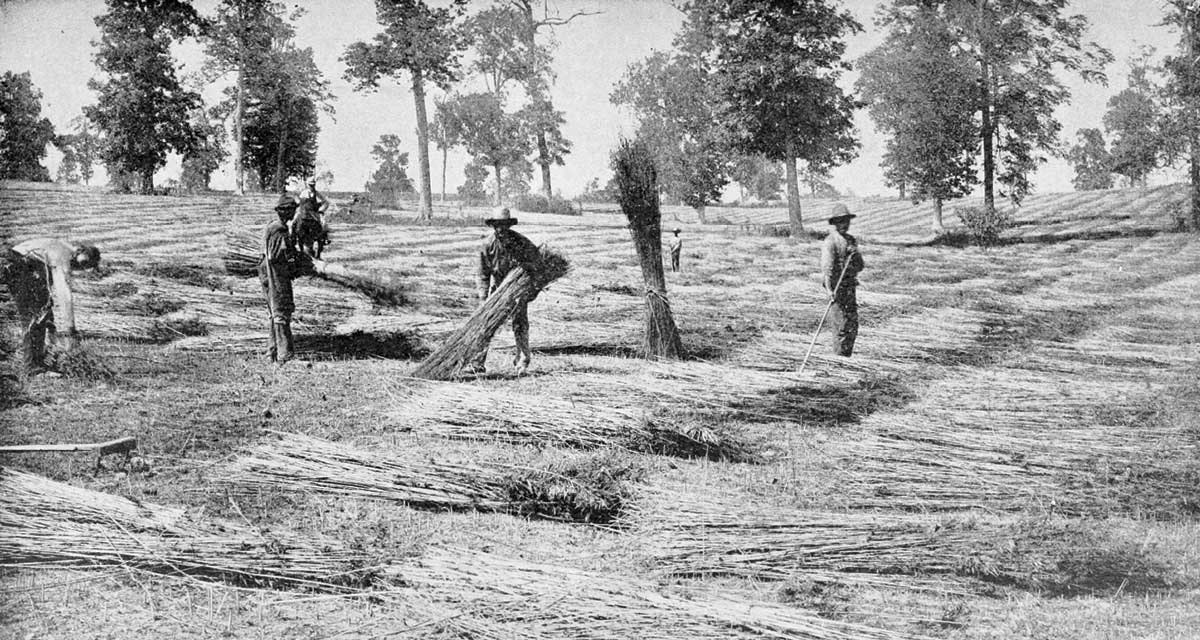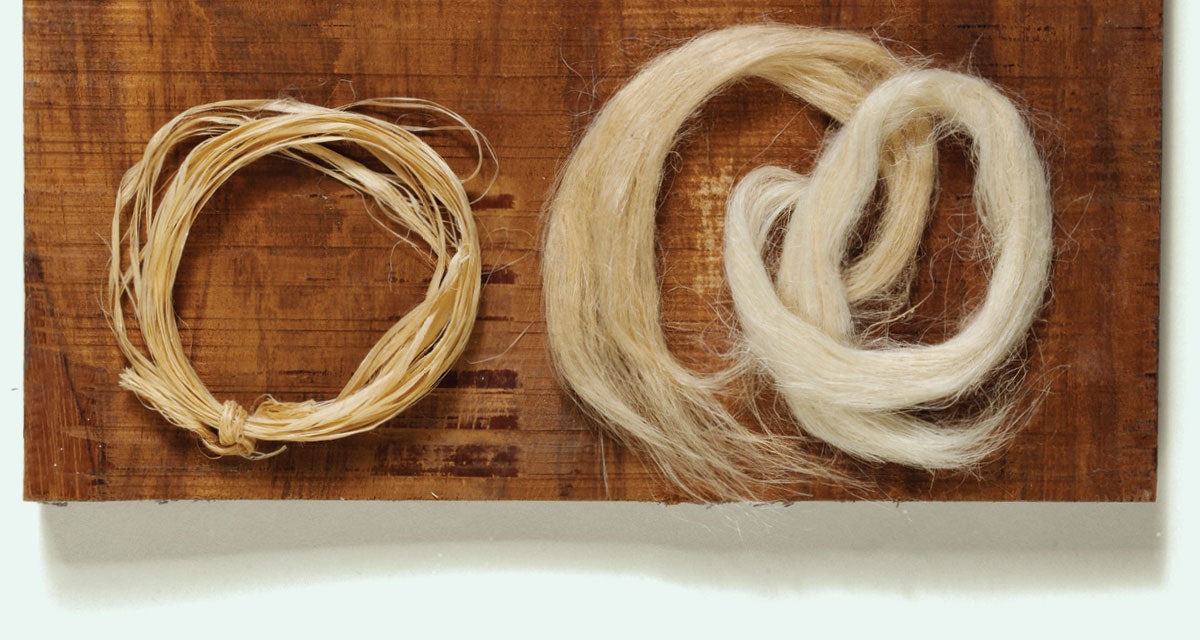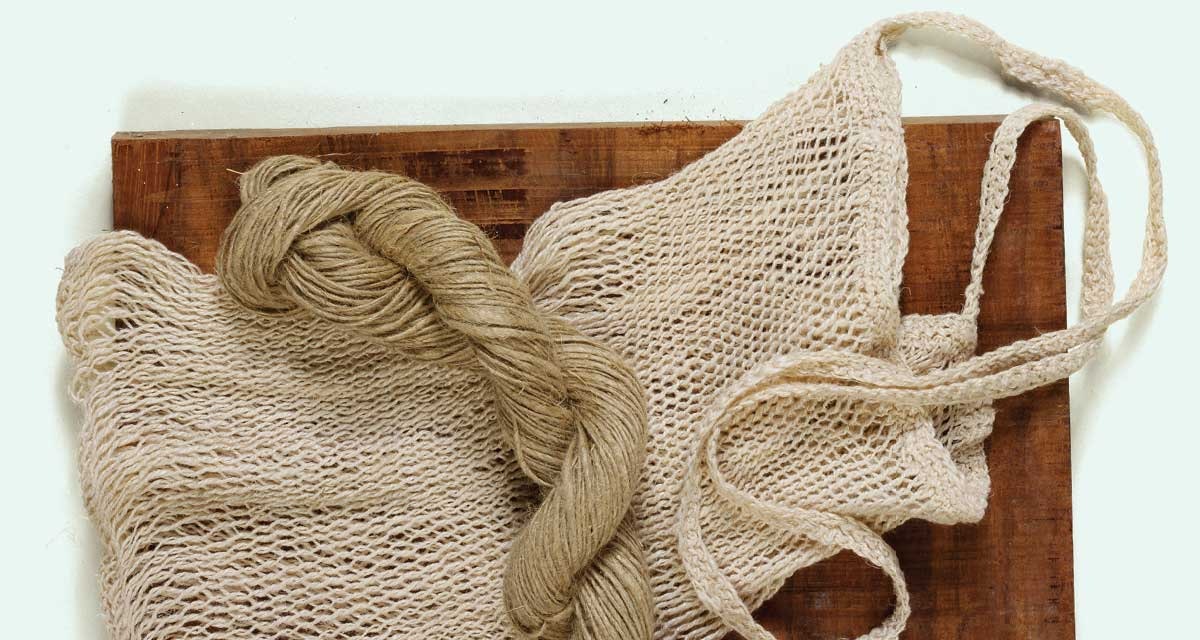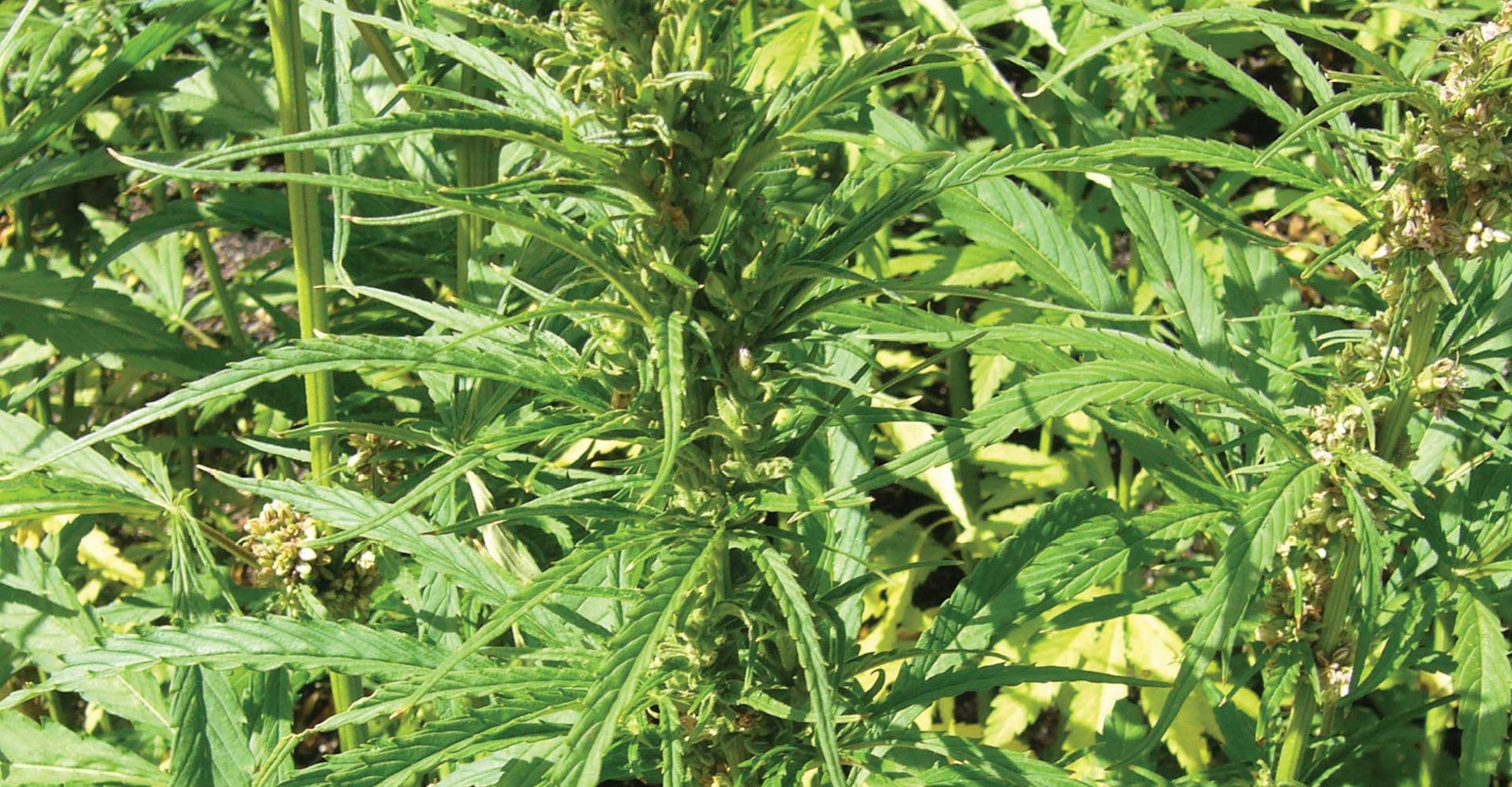Editor’s note: February 4th is national Hemp Day, so we thought we'd share this article from 2015 by Stephenie Gaustad and the late Alden Amos in celebration of this bast fiber. The legal status of growing fiber hemp varies by state, is contantly changing, and it may be prohibited in your area. Consult your local law enforcement agency before embarking on any hemp-growing activities. The following is intended for educational purposes and to deepen your understanding of spinning, not as an endorsement of private hemp cultivation. Any legal consequences are entirely your own. Spinning purchased hemp fiber is not prohibited anywhere to the best of our knowledge. Thanks to Dr. Daniela Vergara of the University of Colorado at Boulder for her expert read of this article.
Hemp is generally accepted worldwide as a valuable agricultural product and fiber source, and we currently see a public, scientific, and governmental acceptance of industrial hemp. This remarkable fiber is also experiencing a rebirth of interest among handspinners, but there is much confusion surrounding its cultivation and use. The purpose of this article is to present information about industrial hemp and hold up some contemporary nonsense to closer scrutiny. (Note that issues involving legalization of hemp’s psychoactive and medicinal twin, marijuana, are beyond the scope of this article. They are two separate industries, two different discussions.)
Recently we met with several groups of handspinners; what follows are some of the questions about hemp that came up. Both Alden Amos (AA) and Stephenie Gaustad (SG) respond.
Q. What is the difference between fiber hemp and marijuana?
SG: Even though there is some scientific discrepancy about the different species comprising the Cannabis genus, it appears as if fiber hemp and marijuana are the same species, Cannabis sativa, which causes much confusion. This leads us to discuss their differing chemistries. Marijuana has a signature amount of a psychoactive cannabinoid: delta-9 tetrahydrocannabinol or “THC.” Hemp has very little THC; the legal description of industrial hemp reads that it must have less than 1⁄3 of 1 percent (0.3%) of THC. It has cannabidiol, or CBD, or other cannabinoids different from THC.
AA: Fiber hemp is raised for seed yield and fiber bulk among various other agricultural traits. Marijuana is not.
Q. Can you get spinning fiber from marijuana?
SG: Marijuana and hemp are not grown the same way. Hemp is crowded and marijuana is planted with lots of space between plants. This makes the marijuana have a thick stem with lots of side branches. The fiber that could be taken from the marijuana plant would be coarse, short, and labor-intensive.
Q. Can you get “high” from handling the fiber, such as when spinning or carding?
SG: Well, you certainly can be utterly enchanted by the beauty of this fiber, its luster, distinction, and strength. But no, industrial hemp does not have many if any psychoactive agents.
AA: Never have heard of anyone getting a toot from spinning and/or carding the stuff, but I have known them to be delighted with their first piece of hempen cloth.
Editor’s note: According to cannabis researchers, another difference is that marijuana is grown for the buds (flowers), while hemp is not. Marijuana plants have been selected for different traits such as big buds (or higher numbers of buds), while hemp has been selected for fiber. So far, we don’t know whether the same plant can produce both big buds and fiber but there could be a trade-off. Since the psychoactive compounds are produced mainly in the buds and hemp produces small buds, it doesn’t make sense for someone to smoke hemp. Additionally, the low THC in hemp will not make you high.
Q. Is it legal where I live?
SG: The status of industrial hemp is in a dizzying state of flux if you live in the United States. The best answer is to do some research: talk to your local sheriff, agricultural extension agent, or a master gardener. I spoke to a friend in law enforcement, casually saying I was writing this article. He began to read me my Miranda rights. (He was joking . . . right?)
AA: Depends on where you live. It’s sort of legal over here, not legal over there. It may be legal over yonder, positively flaming bad news downtown—and subject to change at a moment’s notice.
Editor’s note: Hemp is currently grown in agricultural pilot programs according to the following conditions (113th Congress, 2013-2014, House Report 113-333):
(1) AGRICULTURAL PILOT PROGRAM- The term ‘agricultural pilot program’ means a pilot program to study the growth, cultivation, or marketing of industrial hemp—
(A) in States that permit the growth or cultivation of industrial hemp under the laws of the State; and
(B) in a manner that—
(i) ensures that only institutions of higher education and State departments of agriculture are used to grow or cultivate industrial hemp;
(ii) requires that sites used for growing or cultivating industrial hemp in a State be certified by, and registered with, the State department of agriculture; and
(iii) authorizes State departments of agriculture to promulgate regulations to carry out the pilot program in the States in accordance with the purposes of this section.

Hemp in Kentucky, 1898.
Q. Will I get in trouble growing it?
SG: Regulations on cultivation of industrial hemp are also in a state of flux. It depends on where you live, which country and state. In the United States, if you have a marijuana tax certificate, you can grow marijuana. Within each state, you have a different situation. Some states legalized possession of medical marijuana yet may or may not permit an individual to grow some for personal use. But industrial hemp’s status is not as clear or straightforward.
Q. Where do I get the seeds?
SG: Now, that is the question. If you go online looking for sources, several leap to the front. They are foreign sources. But do understand that within the United States at the time of this writing, transportation of viable seed across state lines is a federal offense. For example, farmers in Kentucky contracted with an out-of-country source for seed, which was impounded by the Drug Enforcement Administration (DEA). The DEA claimed that industrial hemp seed was a Schedule I controlled substance and needed a permit to be released. Ultimately, it was determined that no permit was required, and the seed was released within a week and a crop harvested the following fall. What would your state do?
Q. Can’t you get hemp seed in bird food?
SG: The hemp seed that comes in bird food is degerminated—in other words, it won’t grow.
Q. How many kinds of hemp are there, anyway?
SG: There has been a long-standing difference of opinion concerning the number of varieties of true hemp, the Cannabis genus. The current public consensus is that there are at least two species, C. sativa, C. indica, and a possible third, C. ruderalis.
Q. What about Manila, Indian, sisal, Mauritius, and New Zealand hemp?
SG: None of the above plants are true hemp. Manila hemp (Musa textilis) is a banana leaf fiber, and Indianhemp (Apocynum cannabinum) is a stem or bast fiber but not C. sativa. Sisal (Agave sisalana) and Mauritius (Furcraea foetida) hemps are leaf fibers. Another leaf fiber comes from a lily and is known as New Zealand hemp, Phormium tenax. “Colorado River hemp” is Sesbania macrocarpa, also known as “wild hemp.” It would seem that fiber dealers are using “hemp” more as an evocative term than a precise one.
Q. How tall does the stuff get?
SG: Common hemp grows 6 to 15 feet tall. Historically, hemp was grown very tall, 12 feet or more. That generous length is difficult to handle with contemporary harvesting/processing equipment. Most industrial hemp grown now is less than 8 feet tall.
Q. How do you know when the fiber is mature and ready to harvest?
SG: The male plant, the prime fiber source, dies shortly after flowering. Harvest should follow. If premium fiber is not the goal, then harvest it when seeds are mature. If the fiber and seed are taken when the seed is mature, the fiber will be coarser and lower quality.
AA: In general, when the flowers change color. Some authorities say to harvest both male and female plants at the same time.
Q. I understand you have to ret hemp like flax. How long does that take?
SG: Retting can take from several months to a couple of days. Retting is a temperature-sensitive bacteriological process: the warmer the temperature, the faster the process. Small batches are easier to control if you are going for higher temperature. You can start and stop the process quickly in a trash can in the backyard. Large-scale quality growers prefer a slower retting process like stream or dew retting. Dew retting involves laying out bundled stems in the field where the material was grown. In places where winters are cold and snowy, retting proceeds slowly, resulting in very fine bast fiber.
AA: Several weeks, sometimes more. It depends on the weather. Plus, you cannot let the stems just lie there—they need to be flipped over, jumbled about, and checked often, same as flax. We have gotten a workable ret run, complete with authentic stench, in 72 hours using a plastic wading pool and chlorine-free water. Of course, that was in August, with sunlight for 14-plus hours, for homegrown flax. The stems on flax are puny compared to hemp, so flax retting goes a lot faster. And the stench—until you get a good whiff, you are missing one of the great stinks of all time.
Q. Do you take the seeds out before you ret it?
SG: Yes. Flax and hemp seeds are loaded with oil, making the retting process a mucky mess if the seeds are left in.
Q. What is “decortication?”
AA: It’s a form of mechanical stripping, generally done on vegetable material while it is still “green,” thus the term “green decortications.” Decortication can also be done biologically, as in “flax retting.” Nowadays, industrial hemp is mechanically done, as traditional retting can take a lot of time.
Q. If I process hemp like flax, will I need special tools?
AA: All things being equal, hemp and flax handle about the same, and with the same tools. In general, hemp is a coarser fiber than flax, but that isn’t always the case. We have seen hemp strick that was as nice, as fine, as any flax either of us had worked with. Now, you may get a pronounced difference in fiber length: good hemp ranges from, say, 6 to 10 feet in length, while flax is exceptional if it reaches 4 feet in length. Hemp may have a “waxy” feel about it. That depends upon the preparation. Hemp seems heavier than flax, or at least some people perceive it that way. The only real difference between flax and hemp gear is that the hemp needs larger working areas.
Q. Will wool combs or wool hackles work to process my hemp and flax? SG: The main problem with wool hackles (or combs, for that matter) is that these tools are meant to detangle and take out the short wool bits. The cross section of a wool hackle or comb pin is round and the pin is smooth. Those made for bast fibers are square, with sharp edges as well as points. They are intended to pierce the fiber and make it finer. Many wool combs are pretty light-duty. When used as a hackle, a comb may suffer significant damage: the pins could bend or dislodge.

Q. We don’t have any of those spiked hackle blocks—how do we work around that?
AA: There is no satisfactory substitute for a good set of hackles, but a work-around might be found at your local florist’s supply: those spiked “frogs” or arrangement support blocks. The biggest I’ve seen were oval in shape, maybe 6 inches long and 3 inches wide, with spikes about 1 inch tall. They are better than nothing. Hemp or flax hackles are a far superior product.
Q. Why do some hackles come in sets?
SG: Each block has a limit to how fine it will take the fiber. If you are starting with straw, you need one for rough processing, then one for taking it finer. If you intend to process your hemp or flax to the fineness of handkerchief linen, you will need a third or fourth block.
AA: In traditional use, there would probably be three blocks: fine, with perhaps 100 teeth; medium, with 60 teeth; and coarse, with about 40 teeth. These numbers are approximate; most sets were handmade and reflected whatever the smith felt at the time.
Q. They say that hemp yarn will cut you if you try to break it—is there truth in that?
SG: Oh, yes. It is often called the strongest fiber. Don’t attempt to break it between your hands as you can with wool. Be careful of bast fiber swarf left on the floor, by the way. Sweep it up with a broom rather than a rotating-brush vacuum cleaner. Long bast fiber will gag the Hoover.
AA: It will cause rope burns in a hurry, and in very small sizes. A thread the diameter of a couple of hairs will almost surely cut you before it breaks. This holds true for ramie, flax, and silk as well. It is worse when the thread is wet or waxed. And it’s a good idea to clean and dress the cut— remember what did the cutting and where it’s been . . .

Stripped hemp bast (left) and hemp fiber from two sources (right).
Q. Will moths and other bugs attack hemp yarn or fabric?
SG: Cockroaches, silverfish, and the like will attack hemp if it is handy and damp.
AA: If it is kept clean and dry, it will last like flax—longer, perhaps. Plenty of tomb goods from the arid areas of the world prove this out. Dry and clean is one thing, but what will weaken and destroy hempen fabrics (and all cellulosics, for that matter) is mold and mildew.
Editor’s note: Hemp has several pests according to the very few scientific articles; see www.internationalhempassociation.org/jiha/iha03201.html.
Q. Can you bleach hemp twines and yarns?
SG: Yes, but the best way is the slowest. Wet the yarn or fabric and lay it out in the sun. Then boil it in a slightly alkaline (washing soda) laundry, rinse, and lay it out in the sun. It will become whiter after a few of these cycles.
AA: Yes, but remember that bleaching, no matter how gentle, always weakens the fiber. Gentle bleach equals gentle weakening; plenty of bleach equals plenty of weakening. Old-fashioned crofting methods (as in Steph’s answer above) work well, but take time (say 6, possibly 9, months).
Q. Where did you and Stephenie get all this info?
SG: Our first resource is our own textile library (see Resources). For news and more recent sources, we hit the Web.
AA: If you stop and think about it, you would realize that between the two of us, we have 140-plus years of experience, and 32 years of that has been in cahoots with each other. Seriously, we learned the same way as everyone else. And as for the material for this article? Mostly the United States government.
We apologize for the abruptness of our responses. It was simply due to limited space and desire to cover a generous topic.

Hemp makes wonderful fiber for bags.
Resources
Boyce, S. S. Hemp: A Practical Treatise on the Culture of Hemp for Seed and Fiber with a Sketch of the History and Nature of the Hemp Plant. New York: Orange Judd, 1912.
de Meijer, E. P. M., et al. “The Inheritance of Chemical Phenotype in Cannabis sativa L.” Genetics 163 (2003): 335−346.
Dewey, Lester H. “The Hemp Plant.” In Yearbook of the United States Department of Agriculture, 1901, pages 542–554. Washington, D.C.: Government Printing Office, 1901.
———. “Hemp.” In Yearbook of the United States Department of Agriculture, 1913, pages 283–346. Washington, D.C.: Government Printing Office, 1913.
Hillig, K. W. “Genetic Evidence for Speciation in Cannabis (Cannabaceae).” Genetic Resources and Crop Evolution 52 (2005): 161−180.
Hillig, K. W., and P. G. Mahlberg. “A Chemotaxonomic Analysis of Cannabinoid Variation in Cannabis (Cannabaceae).” American Journal of Botany 91 (2004): 966−975.
Li, H.-L. “An Archaeological and Historical Account of Cannabis in China.” Economic Botany 28 (1974): 437−448.
———. “Origin and Use of Cannabis in Eastern Asia: Linguistic-Cultural Implications.” Economic Botany 28 (1974): 293−301.
Matthews, J. M. The Textile Fibers: Their Physical, Microscopical and Chemical Properties. New York: J. Wiley & Sons, 1916.
Russo, E. B. “History of Cannabis and Its Preparations in Saga, Science, and Sobriquet.” Chemistry & Biodiversity 4 (2007): 1614−1648.
van Bakel, H., et al. “The Draft Genome and Transcriptome of Cannabis sativa.” Genome Biology 12 (10) (2011): R106.
Online link to information on industrial hemp cultivation: catalog.extension.oregonstate.edu/sb681
Online link to state industrial hemp statutes: www.ncsl.org/research/agriculture-and-rural-development/state-industrial-hemp-statutes.aspx
Alden Amos was a writer and wheel maker. He was a collaborator in the video Know Your Wheel, and his Big Book of Handspinning is a classic in the craft. Stephenie Gaustad is an author, teacher, and illustrator with a passion for historic textiles and cellulose fibers (hence her video Spinning Cotton).
This article was published in the Summer 2015 issue of Spin Off.

